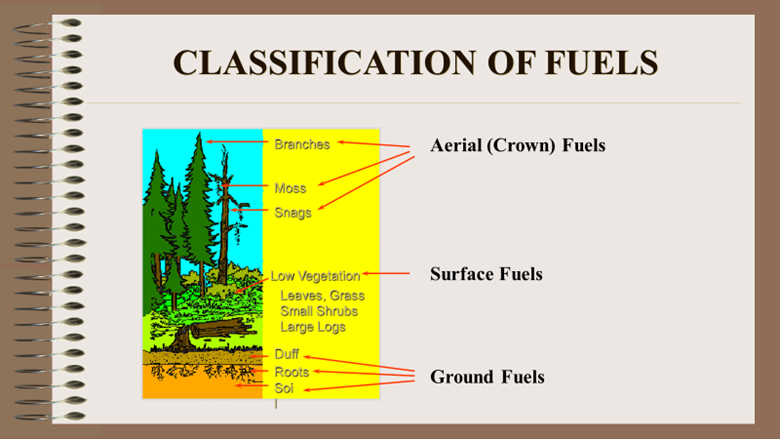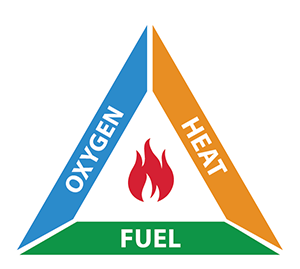Forest fuels are all the burnable materials in the forest, from underground to treetops.
It is helpful to think of forest fuels in layers. First, ground fuels are within the soil and are the “duff” or organic parts of dirt and underground roots. Second, surface fuels are low vegetation, including leaves, grass, small shrubs and large fallen logs. Lastly, aerial or crown fuels are the trunks, branches, leaves on large living trees and standing snags or dead trees and the mosses on them. Some, but not all, of these layers are involved in most wildfires.

The most commonly burned layers are ground and surface fuels which will burn in low to moderately intense ground fires. Very intense crown fires involving all the layers are relatively uncommon. They usually only occur due to extreme weather influences and fires burning on steep slopes or in dense fuels.
Wildfires move through forest fuel layers seeking new fuel to maintain the fire. Therefore, on larger fires, it is common for one part of the fire to have different fire behaviour from another area. The fire behaviour can also vary over the day as temperature and wind generally increase from late morning to evening and lessen overnight.
Fuel types
Some fuel types are more flammable than others. For example, some plants contain more resins and ignite easily, like black spruce and pine. Conversely, deciduous trees like poplars have moist, supple leaves and a water-like sap which results in a lower amount of sap or resin and does not ignite as easily.
Fuel continuity refers to the distribution of fuels over a given area and is described as patchy or uniform. The volume or amount of flammable material will impact the amount of heat a fire produces.
The shape and size of the fuel affect the time required for it to dry out or take in moisture and how fast a fire pre-heats fuels in front of it. Light fuels such as dry grasses, dead leaves, needles, small brush and small trees cause rapid spread and act as kindling for heavier fuels. Heavy fuels like stumps, large logs, heavy branches and deep duff are slower burning, but fires involving these fuels are harder to put out. Heavy fuels often require crews to break apart these fuels or dig deep underground and extinguish all the inside heat.

Fires in loosely compacted fuels burn rapidly because individual fuel parts are freely exposed to air. On the other hand, compacted fuels such as piled logging debris and duff burn slower because of the lack of space for oxygen between the fuel pieces.
“Forest fuels are a critical component in the fire behaviour triangle. Wildfires can react very differently to forest fuels depending on their arrangement, type, moisture and composition.”
Greg Boyachuk, Senior Wildfire Officer – Operations for the Coastal Fire Centre.
Forest fuels will ignite easier, and the fire spreads faster with lower fuel moisture. Fuel moisture content is impacted by the amount of moisture the fuels can absorb from the air and the percentage of live or dead (cured) fuel. For example, uncured green grass will not burn as well as brown grass. In addition, the sun’s heat will impact fuel moisture, with fuels under dense shade drying out slower and fuels on south-facing slopes drying faster.
If this sounds familiar, you might have heard about the importance of understanding forest fuels through FireSmart programs or when Cultural Fire or Prescribed Fire projects are discussed. Altering the arrangement, spacing, species and loading of the fuels in the forest or on properties will make wildfires burn less intensely and easier to control.
Weather and topography
Weather factors also influence how fires burn. For example, relative humidity, wind velocity and direction, temperature, atmospheric stability and precipitation will increase or decrease fire behaviour. In addition, the topography the fire burns on, such as slope steepness, the aspect of the slope (how the slope faces the sun), elevation, fire barriers such as landslides or rivers or lakes, and the land’s shape will also influence how the fire burns. All of these factors are considered as BC Wildfire Service staff determine the best way to bring fires under control.
To learn more about wildfire behaviour, visit bcwildfire.ca.
